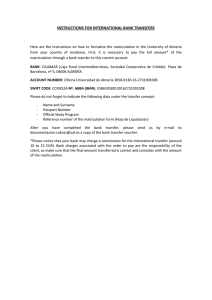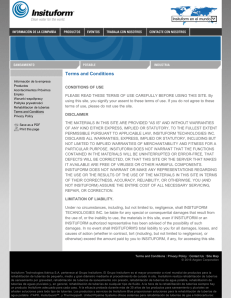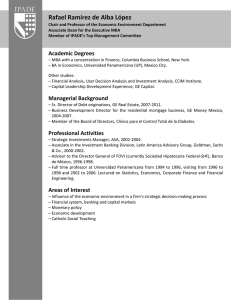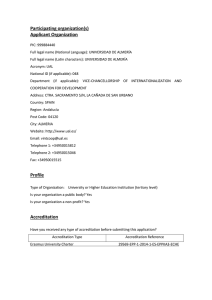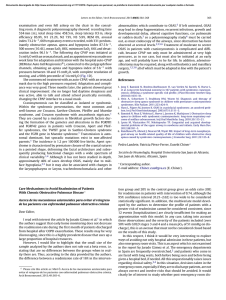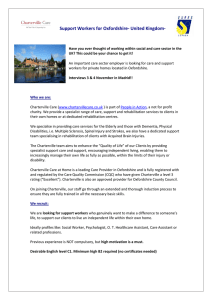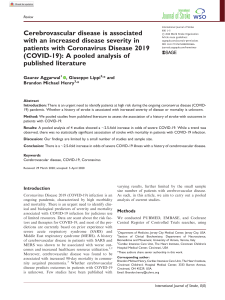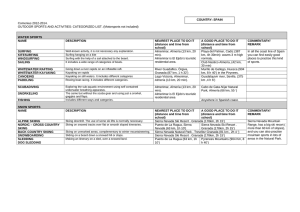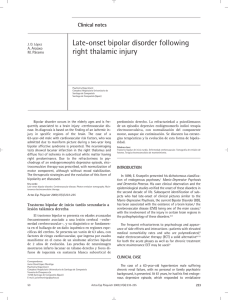Anuncio
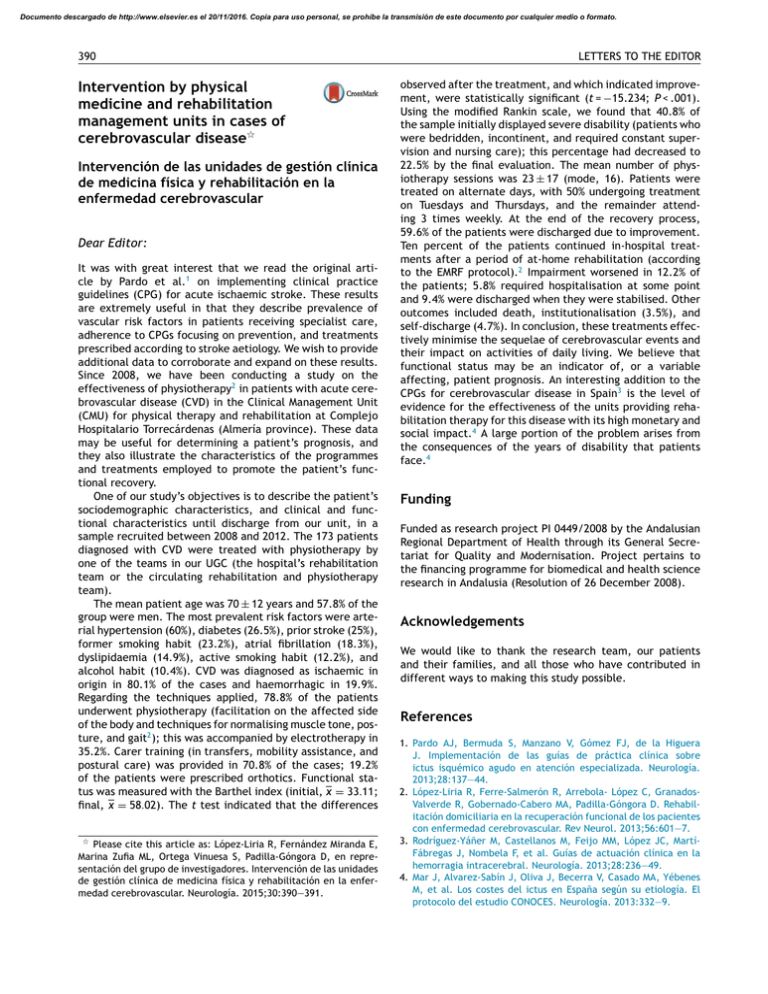
Documento descargado de http://www.elsevier.es el 20/11/2016. Copia para uso personal, se prohíbe la transmisión de este documento por cualquier medio o formato. 390 Intervention by physical medicine and rehabilitation management units in cases of cerebrovascular disease夽 Intervención de las unidades de gestión clínica de medicina física y rehabilitación en la enfermedad cerebrovascular Dear Editor: It was with great interest that we read the original article by Pardo et al.1 on implementing clinical practice guidelines (CPG) for acute ischaemic stroke. These results are extremely useful in that they describe prevalence of vascular risk factors in patients receiving specialist care, adherence to CPGs focusing on prevention, and treatments prescribed according to stroke aetiology. We wish to provide additional data to corroborate and expand on these results. Since 2008, we have been conducting a study on the effectiveness of physiotherapy2 in patients with acute cerebrovascular disease (CVD) in the Clinical Management Unit (CMU) for physical therapy and rehabilitation at Complejo Hospitalario Torrecárdenas (Almería province). These data may be useful for determining a patient’s prognosis, and they also illustrate the characteristics of the programmes and treatments employed to promote the patient’s functional recovery. One of our study’s objectives is to describe the patient’s sociodemographic characteristics, and clinical and functional characteristics until discharge from our unit, in a sample recruited between 2008 and 2012. The 173 patients diagnosed with CVD were treated with physiotherapy by one of the teams in our UGC (the hospital’s rehabilitation team or the circulating rehabilitation and physiotherapy team). The mean patient age was 70 ± 12 years and 57.8% of the group were men. The most prevalent risk factors were arterial hypertension (60%), diabetes (26.5%), prior stroke (25%), former smoking habit (23.2%), atrial fibrillation (18.3%), dyslipidaemia (14.9%), active smoking habit (12.2%), and alcohol habit (10.4%). CVD was diagnosed as ischaemic in origin in 80.1% of the cases and haemorrhagic in 19.9%. Regarding the techniques applied, 78.8% of the patients underwent physiotherapy (facilitation on the affected side of the body and techniques for normalising muscle tone, posture, and gait2 ); this was accompanied by electrotherapy in 35.2%. Carer training (in transfers, mobility assistance, and postural care) was provided in 70.8% of the cases; 19.2% of the patients were prescribed orthotics. Functional status was measured with the Barthel index (initial, x̄ = 33.11; final, x̄ = 58.02). The t test indicated that the differences 夽 Please cite this article as: López-Liria R, Fernández Miranda E, Marina Zufia ML, Ortega Vinuesa S, Padilla-Góngora D, en representación del grupo de investigadores. Intervención de las unidades de gestión clínica de medicina física y rehabilitación en la enfermedad cerebrovascular. Neurología. 2015;30:390—391. LETTERS TO THE EDITOR observed after the treatment, and which indicated improvement, were statistically significant (t = −15.234; P < .001). Using the modified Rankin scale, we found that 40.8% of the sample initially displayed severe disability (patients who were bedridden, incontinent, and required constant supervision and nursing care); this percentage had decreased to 22.5% by the final evaluation. The mean number of physiotherapy sessions was 23 ± 17 (mode, 16). Patients were treated on alternate days, with 50% undergoing treatment on Tuesdays and Thursdays, and the remainder attending 3 times weekly. At the end of the recovery process, 59.6% of the patients were discharged due to improvement. Ten percent of the patients continued in-hospital treatments after a period of at-home rehabilitation (according to the EMRF protocol).2 Impairment worsened in 12.2% of the patients; 5.8% required hospitalisation at some point and 9.4% were discharged when they were stabilised. Other outcomes included death, institutionalisation (3.5%), and self-discharge (4.7%). In conclusion, these treatments effectively minimise the sequelae of cerebrovascular events and their impact on activities of daily living. We believe that functional status may be an indicator of, or a variable affecting, patient prognosis. An interesting addition to the CPGs for cerebrovascular disease in Spain3 is the level of evidence for the effectiveness of the units providing rehabilitation therapy for this disease with its high monetary and social impact.4 A large portion of the problem arises from the consequences of the years of disability that patients face.4 Funding Funded as research project PI 0449/2008 by the Andalusian Regional Department of Health through its General Secretariat for Quality and Modernisation. Project pertains to the financing programme for biomedical and health science research in Andalusia (Resolution of 26 December 2008). Acknowledgements We would like to thank the research team, our patients and their families, and all those who have contributed in different ways to making this study possible. References 1. Pardo AJ, Bermuda S, Manzano V, Gómez FJ, de la Higuera J. Implementación de las guías de práctica clínica sobre ictus isquémico agudo en atención especializada. Neurología. 2013;28:137—44. 2. López-Liria R, Ferre-Salmerón R, Arrebola- López C, GranadosValverde R, Gobernado-Cabero MA, Padilla-Góngora D. Rehabilitación domiciliaria en la recuperación funcional de los pacientes con enfermedad cerebrovascular. Rev Neurol. 2013;56:601—7. 3. Rodríguez-Yáñer M, Castellanos M, Feijo MM, López JC, MartíFábregas J, Nombela F, et al. Guías de actuación clínica en la hemorragia intracerebral. Neurología. 2013;28:236—49. 4. Mar J, Alvarez-Sabín J, Oliva J, Becerra V, Casado MA, Yébenes M, et al. Los costes del ictus en España según su etiología. El protocolo del estudio CONOCES. Neurología. 2013:332—9. Documento descargado de http://www.elsevier.es el 20/11/2016. Copia para uso personal, se prohíbe la transmisión de este documento por cualquier medio o formato. LETTERS TO THE EDITOR 391 R. López-Liria a,∗ , E. Fernández Miranda b , M.L. Marina Zufia b , S. Ortega Vinuesa b , D. Padilla-Góngora a , representing the group of researchers b Unidad de Gestión Clínica de Medicina Física y Rehabilitación, Complejo Hospitalario Torrecárdenas, Servicio Andaluz de Salud, Almería, Spain a ∗ Facultad de Ciencias de la Educación, Enfermería y Fisioterapia, Universidad de Almería, Almería, Spain Corresponding author. E-mail address: [email protected] (R. López-Liria).
